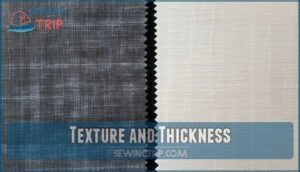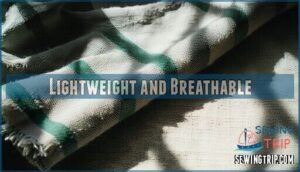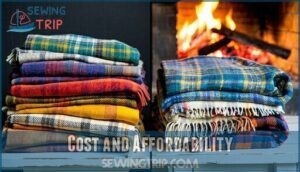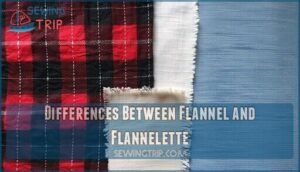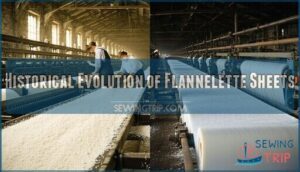This site is supported by our readers. We may earn a commission, at no cost to you, if you purchase through links.
 You’ll find the difference between flannel and flannelette comes down to composition and weight.
You’ll find the difference between flannel and flannelette comes down to composition and weight.
Flannel typically contains wool or wool-cotton blends, making it thicker and more durable for outdoor use.
Flannelette mimics flannel’s brushed softness but uses lighter cotton, creating a breathable fabric that’s perfect for sheets and lightweight clothing.
While stores often use these terms interchangeably, true flannel offers superior warmth and longevity, whereas flannelette provides comfort at a lower cost.
Both share that cozy, fuzzy texture you love, but their different weaving methods affect durability, which helps you choose the right fabric for your specific comfort needs and climate preferences.
Table Of Contents
- Key Takeaways
- Flannel Vs. Flannelette
- Characteristics of Flannel
- Characteristics of Flannelette
- Differences Between Flannel and Flannelette
- Pros and Cons of Flannel
- Proper Usage in Sentences
- Historical Evolution of Flannelette Sheets
- Eco-Friendly Benefits of Flannelette Sheets
- Making Informed Fabric Choices
- Frequently Asked Questions (FAQs)
- Conclusion
Key Takeaways
- You’ll get better warmth and durability with flannel since it’s made from wool or wool-cotton blends with a thicker, tighter weave that traps more air for insulation.
- You’ll find flannelette more affordable and breathable because it uses lighter cotton blends with single-sided brushing, making it perfect for year-round comfort without overheating.
- You’ll pay 40-60% more for flannel ($6-15 per yard) compared to flannelette ($2-5 per yard), but you’ll get superior longevity and weather resistance for outdoor use.
- You’ll need to match your fabric choice to your climate—flannel excels in cold winters while flannelette works better in moderate temperatures where you don’t want excessive warmth.
Flannel Vs. Flannelette
When you’re shopping for cozy fabrics, understanding flannel vs flannelette can save you money and guarantee comfort.
These two fabrics differ substantially in fiber content, weave density, and thermal properties.
Flannel fabric typically contains wool, cotton, or synthetic blends with a tighter weave density.
The napping process creates brushed surfaces on both sides, boosting thermal properties for cold weather.
You’ll pay more—around $6-15 per yard—but get superior durability.
Flannelette fabric uses lighter cotton blends with less dense weaving.
Its single-sided napping process creates softness without excessive weight.
The fabric weight stays minimal, making it breathable for year-round use.
At $2-5 per yard, it’s budget-friendly.
The key difference lies in their construction: flannel’s double-sided brushing and denser weave trap more air for insulation, while flannelette’s lighter structure provides comfort without overheating.
Choose flannel for winter warmth, flannelette for year-round breathability—it’s that simple.
Think of flannel as your winter coat—substantial and warm.
Flannelette’s more like a light sweater—soft and versatile.
Characteristics of Flannel
You’ll discover that flannel stands out as the heavyweight champion of cozy fabrics, built with robust materials and superior craftsmanship.
Understanding flannel’s unique characteristics helps you make smarter fabric choices for your specific needs.
Fabric Composition
Understanding flannel’s fabric composition helps you make better choices for your projects.
Cotton flannel leads today’s market, while wool flannel provides superior warmth during harsh winters.
You can find various cotton flannels online.
Key Composition Elements:
- Material Origin – Traditional flannel started with carded wool, modern versions use cotton or synthetic fiber blends
- Fiber Blends – Cotton-polyester combinations offer durability while maintaining softness and breathability
- Weave Density – Flannel fabric features tighter construction compared to flannelette fabric’s looser weave
- Production Methods – Fabric weight varies based on yarn thickness and manufacturing techniques used
Cotton flannelette uses lightweight cotton blends for year-round comfort, making it perfect for baby clothes and summer bedding.
Texture and Thickness
Texture tells the whole story when you’re comparing flannel and flannelette materials.
Flannel material features a distinctive napped, brushed surface on both sides through an intensive napping process, creating superior thermal properties and heat retention.
Its weave density contributes to a coarser hand feel that’s perfect for cold weather comfort.
Meanwhile, flannelette fabric offers a softer, more delicate fuzzy texture achieved through lighter brushing.
This fluffier texture results from reduced fabric weight and gentler processing.
You can find various products related to flannel fabric texture.
Consider these texture differences:
- Flannel’s double-sided napping creates that signature thick, substantial feel you’ll love on chilly nights
- Flannelette material delivers silky smoothness that’s gentle enough for sensitive skin and babies
The contrast in hand feel becomes obvious once you touch both fabrics.
Flannel’s robust texture speaks to durability, while flannelette’s lightweight nature prioritizes comfort and breathability for year-round use.
Durability and Outdoor Use
Building flannel for tougher tasks means choosing fabric strength that won’t let you down.
Flannel durability outshines flannelette in outdoor applications, thanks to its tightly woven fibers that resist tears and punctures.
You’ll find heavyweight flannel perfect for workwear jackets that need weather resistance.
This fabric maintains its shape through countless washes, making it ideal for long-term use in demanding environments.
While flannelette works great indoors, flannel’s superior durability makes it your go-to choice for outdoor adventures.
Flannel also excels as a layering component for insulation in outdoor clothing, providing a great combination of warmth and weather resistance.
Historical Origin
Tracing back through history, you’ll discover that flannel’s journey began in the mountainous regions of Wales during the 16th century.
Welsh weavers crafted this remarkable fabric from carded wool, creating a textile that would eventually warm homes across the globe. The fabric’s name itself reflects its Welsh Origins, derived from the Welsh word "gwlanen."
Here’s how flannel spread across continents:
- European expansion: By the 17th century, flannel had crossed borders into France and Germany, where it became known as "flanelle" and "flanell"
- Industrial Revolution transformation: The 1800s brought mechanized production, making flannel affordable for working families who previously couldn’t access such luxury
- Global Spread acceleration: Trade routes carried Welsh flannel techniques worldwide, establishing mills from America to Australia
This Fabric Evolution during the Industrial Revolution also sparked flannelette’s creation—a lighter, cotton-based alternative that offered similar comfort at lower costs. Early Uses included everything from undergarments to blankets, cementing flannel’s place in textile history. Understanding the fabric’s warmth retention is key to appreciating its historical significance.
Characteristics of Flannelette
When you’re shopping for soft fabrics, you’ll notice flannelette feels lighter and more breathable than its heavier cousin flannel.
This cotton-blend fabric gets its signature softness from a special brushing process that raises the fibers, making it perfect for year-round comfort without the bulk.
Lightweight and Breathable
Flannelette fabric offers exceptional breathability that keeps you comfortable during warmer months.
Unlike heavier cotton flannel, this lightweight textile allows air to circulate freely, preventing overheating in summer sleepwear and baby clothing.
The fabric’s moisture management properties wick away perspiration, making it ideal for active wear and climate comfort.
For example, cotton offers inherent breathability, making it a great choice for similar applications.
Through smart fabric comparison, you’ll notice flannelette’s textile differences create perfect ventilation without sacrificing the cozy feel you love.
Softness and Moisture-Wicking
Several soft fabrics deliver exceptional comfort, but flannelette fabric stands out with its superior softness retention and wicking ability.
The brushed cotton flannel creates a gentle fabric feel that’s perfect for baby clothing and sensitive skin.
Unlike regular cotton flannel, flannelette’s moisture-wicking properties pull sweat away from your body, keeping you dry throughout the night.
This climate comfort makes it ideal for year-round use.
When comparing softness comparison between fabrics, flannelette consistently ranks highest for comfort and breathability.
Cost and Affordability
Your wallet will thank you when choosing flannelette fabric over traditional flannel. Material costs drive significant price differences between these cozy options. Flannelette’s cotton-synthetic blend keeps production expenses lower, while flannel’s pure materials increase retail pricing substantially.
Budget options abound with flannelette, offering excellent long-term value for cost-conscious shoppers. As a versatile material, flannel fabric sees common use in apparel and homewares.
Consider these fabric cost comparisons:
- Flannelette sheets: $20-$50 for quality comfort without breaking the bank
- Basic flannel sets: $35-$75, reflecting higher material and production expenses
- Premium flannel: 40-60% price increase over standard flannelette alternatives
- Seasonal sales favor flannelette due to higher retailer inventory volumes
Differences Between Flannel and Flannelette
You’ve probably heard these fabric names tossed around like they’re identical twins, but flannel and flannelette aren’t quite the same thing.
While many people use the terms interchangeably in casual conversation, understanding their distinct characteristics helps you choose the right fabric for your specific needs.
Usage Interchangeability
Modern retailers often blur the line between flannel and flannelette, creating term confusion that affects consumer perception.
You’ll find flannel shirts labeled as flannelette and flannelette sheets marketed as flannel.
This marketing impact stems from retailers prioritizing retail clarity over technical accuracy, leading to a situation where many consumers view these interchangeable terms as synonymous, though language evolution hasn’t eliminated their distinct meanings.
Understanding this helps you navigate product descriptions and make informed choices when shopping for these similar fabrics, which is crucial for making the right decision based on your needs, considering the technical accuracy of the terms.
Contextual Considerations
Looking beyond interchangeable terms, context shapes your fabric choice substantially.
Fabric Purpose determines whether you need flannel’s durability for outdoor gear or flannelette’s gentleness for baby clothes.
Climate Impact matters—flannel weave handles winter’s bite while flannelette weave breathes in milder weather.
Personal Needs and Budget Matters influence decisions too, consider Ethical Sourcing when possible.
Think of it like choosing between a winter coat and a light jacket—both serve different purposes perfectly.
Climate and Seasonal Suitability
Your climate dictates fabric choice more than personal preference.
Your climate decides your comfort level, not your shopping list.
Flannel excels in cold weather through superior insulation and layering options, while flannelette shines in milder temperatures with better breathability.
Summer flannel becomes uncomfortably warm, making winter flannelette your go-to for seasonal comfort.
Choose flannel for harsh winters and flannelette for moderate climates where warmth matters but overheating doesn’t.
Personal Preferences
Texture preference shapes your comfort experience substantially.
Some people crave flannel’s cozy thickness, while others prefer flannelette’s lighter touch.
Climate comfort matters too—flannel excels in winter, but flannelette works year-round.
Budget matters when choosing between these fabrics.
Flannelette costs less, making it wallet-friendly for families.
Sensory sensitivity plays a role since flannel feels heavier against skin.
Ethical concerns might influence your choice if you prefer cotton over synthetic blends.
Your personal preferences ultimately determine which fabric suits your lifestyle best, considering comfort experience and texture preference.
Quality and Thickness
When you choose between flannel and flannelette, fabric quality and thickness make all the difference.
Think of flannel as the heavyweight champion – its weave density creates a tighter, more durable structure that’ll last through countless washes.
The napping process brushes both sides, creating that luxurious feel you’ll love on cold nights.
Flannelette takes a lighter approach.
Its material blends, often cotton-polyester combinations, produce thinner fabric that’s perfect when you don’t need heavy-duty warmth.
The weave isn’t as tight, but that’s actually a feature – it creates better breathability for year-round comfort.
Here’s the real scoop: flannel’s thickness impact means superior insulation, while flannelette’s fiber quality focuses on softness over durability.
You’re basically choosing between a winter coat and a light sweater.
Both have their place, but understanding these differences helps you pick the right fabric for your specific needs and climate.
Pros and Cons of Flannel
Now that you understand the key differences between these fabrics, flannel brings both advantages and drawbacks worth considering.
Flannel Warmth stands out as its biggest selling point—you’ll stay cozy during cold nights thanks to its superior insulation properties. The Durability Factors work in your favor too, as quality flannel withstands years of washing without falling apart.
Allergen Resistance makes flannel a smart choice if you’re sensitive to dust mites, since its tight weave blocks these irritants effectively. However, Cost Analysis reveals flannel typically costs 25-40% more than flannelette, which might stretch your budget.
The Care Requirements can be tricky—wool flannel needs gentle handling to prevent shrinkage, while cotton flannel’s easier to maintain. You’ll also find flannel feels too heavy during summer months, making it purely seasonal bedding.
Despite these limitations, flannel’s combination of comfort and longevity makes it worthwhile for cold-weather sleepers who don’t mind the extra expense. Flannel’s warmth comes from its napping process and weave, creating a soft, insulating layer.
Proper Usage in Sentences
You’ll master the difference between flannel and flannelette by seeing them in action through real examples.
Understanding their proper usage prevents embarrassing mix-ups when shopping for bedding or describing your favorite cozy shirt, and it is crucial for effective communication about these materials.
Flannel Usage Examples
Choosing flannel transforms your comfort experience across multiple settings.
You’ll find flannel shirts perfect for crisp autumn days, providing reliable warmth without bulk.
Winter bedding made from flannel creates a cozy sanctuary during cold months.
Outdoor gear featuring flannel linings offers essential insulation for camping trips.
Baby blankets crafted from soft flannel provide gentle warmth for little ones.
Craft projects using flannel remnants let you create unique sleepwear and clothing items with that signature brushed texture.
Flannelette Usage Examples
Real-world applications show flannelette’s versatility across various household needs.
You’ll find this lightweight fabric perfect for baby clothing due to its gentle, brushed texture that won’t irritate sensitive skin.
Parents often choose flannelette diapers because they’re softer than traditional options while maintaining excellent absorption.
For bedding options, flannelette sheets offer year-round comfort without the heaviness of traditional flannel.
The fabric’s moisture-wicking properties make it ideal for sleepwear, especially children’s pajama applications where breathability matters most.
Here are four key flannelette applications:
- Baby essentials: Gentle enough for newborn clothing and receiving blankets
- Seasonal bedding: Perfect weight for spring and fall comfort
- Craft projects: Easy to work with for quilting and home decor items
- Home decor: Adds cozy texture to curtains and throw pillows
Whether you’re shopping for nursery essentials or updating your bedroom, flannelette delivers comfort without bulk.
Common Mistakes to Avoid
People often confuse flannel and flannelette, creating fabric selection headaches.
Misunderstanding care requirements leads to shrinkage disasters when you wash wool flannel like cotton. Ignoring shrinkage warnings ruins expensive bedding.
Overlooking blends means missing durability benefits of cotton-synthetic combinations. Disregarding texture differences causes comfort issues—flannel’s thickness versus flannelette’s lightweight feel matters.
Confusing warmth levels results in overheating with heavy flannel during mild weather. Remember: flannel suits cold climates, while flannelette works year-round for breathable comfort.
Historical Evolution of Flannelette Sheets
Looking at fabric usage in sentences helps set the stage for understanding how these materials developed over time.
Flannelette’s story starts in 19th-century Wales, where clever textile workers created this cotton-based fabric as an affordable alternative to expensive wool flannel.
The Industrial Revolution changed everything for flannelette production.
Early Manufacturing relied on hand-brushing techniques, but mechanized carding mills transformed how workers processed cotton fibers.
This Cotton Shift from wool to cotton made flannelette accessible to working-class families who couldn’t afford traditional flannel.
Welsh origins shaped flannelette’s character through generations of textile expertise.
Local craftsmen perfected brushing methods that created the fabric’s signature soft surface.
As demand grew, Global Adoption spread flannelette across Europe and North America.
Cotton offers breathability, making it ideal for various uses.
Modern Production now uses advanced machinery to create consistent napping and improved durability.
Today’s flannelette sheets maintain their historical origins while benefiting from centuries of manufacturing refinement, proving that good ideas never go out of style.
Eco-Friendly Benefits of Flannelette Sheets
Beyond mere comfort, flannelette sheets offer compelling environmental advantages that make your bedroom both cozy and conscientious.
Organic cotton flannelette eliminates toxic pesticides while supporting healthier ecosystems through sustainable sourcing practices.
Consider these ecofriendly benefits:
- Reduced Environmental Impact – Organic cotton production uses less water and energy compared to conventional methods
- Lower Chemical Exposure – Non-toxic dyes and chemical-free processing create safer sleep environments
- Enhanced Biodegradability – Natural fibers break down easily, reducing landfill waste
Ethical production standards guarantee fair labor practices while sustainably sourced materials support responsible farming.
This reduced waste approach means you’re investing in bedding that’s gentle on both your skin and the planet.
Making Informed Fabric Choices
You’ll face countless fabric choices when shopping for bedding, clothing, or home textiles, but understanding the key differences between flannel and flannelette can save you from buyer’s remorse and guarantee you get exactly what you need.
Making the right choice depends on your specific purpose, local climate, personal comfort preferences, and how long you want the fabric to last.
Choosing Based on Purpose
Your fabric choice depends on your specific needs and Intended Use. For winter clothing, outdoor gear, and heavy-duty applications, flannel’s superior durability and warmth retention make it the clear winner.
Its material characteristics handle harsh conditions better than lighter alternatives. Flannelette works best for lightweight pajamas, baby clothes, and year-round bedding.
Its fabric properties offer breathability without sacrificing softness. Consider your Activity Level too—active outdoor enthusiasts need flannel’s toughness, while those seeking comfortable sleepwear prefer flannelette’s gentle touch.
Budget Constraints also matter. Flannelette costs $2-5 per yard versus flannel’s $6-15 range. Your Personal Style preferences and Climate Considerations should guide your decision.
You can find flannel outdoor gear for rugged use. Match the fabric to your purpose, and you’ll get exactly what you need.
Considering Climate
Your climate shapes which fabric delivers ideal comfort year-round.
In frigid winters, flannel’s thick weave and napped surface trap warmth effectively, making it perfect for seasonal comfort in cold regions.
Hot summers call for flannelette’s lightweight breathability—it won’t leave you overheated.
Regional variations matter too: tropical climates favor flannelette’s cooling properties, while northern areas benefit from flannel’s superior insulation.
Weather application determines your best choice for ultimate use.
Evaluating Personal Comfort
Personal comfort isn’t one-size-fits-all when choosing between flannel and flannelette.
Your sensory preferences play a huge role—some folks crave the plush softness of flannelette’s brushed surface, while others prefer flannel’s substantial feel.
Climate sensitivity matters too; if you’re always cold, flannel’s superior warmth retention beats flannelette hands down.
Consider your activity level and skin sensitivity as well.
Hot sleepers often find flannelette’s breathability more comfortable than flannel’s heat-trapping properties.
Budget considerations shouldn’t be overlooked either—flannelette typically costs less while still delivering decent comfort.
Test both fabrics if possible, since what feels cozy to your neighbor might feel scratchy to you, and your personal comfort zone ultimately determines the winner, based on factors like climate sensitivity and skin sensitivity.
Quality and Durability Assessment
When examining fabric durability, you’re basically looking at how well your investment will hold up over years of use.
Quality flannel and flannelette differ substantially in their construction and longevity.
Here’s what to evaluate for lasting performance:
- Weave Strength – Check how tightly fibers are woven together, as this directly impacts fabric resilience
- Abrasion Resistance – Test how well the material withstands repeated friction from washing and daily use
- Pilling Potential – Look for fabrics that won’t develop those annoying little balls after a few washes
- Long-Term Value – Consider cost per year of use rather than just upfront price
Flannel typically offers superior durability comparison due to its denser construction, while flannelette provides decent fabric quality at a lower price point.
Understanding these fabric durability factors helps you choose bedding that won’t disappoint after your first winter season together.
Frequently Asked Questions (FAQs)
Are flannel and flannelette the same thing?
Coincidentally, these two fabrics share similar names but aren’t identical.
You’ll find flannel’s typically made from wool or cotton with superior warmth and durability, while flannelette’s a lighter, cotton-based alternative that’s more affordable and breathable.
Why can’t you tumble dry flannelette sheets?
You shouldn’t tumble dry flannelette sheets because the heat can cause shrinkage, damage the soft brushed fibers, and lead to pilling that ruins their smooth texture.
What do Americans call flannelette?
Ever wondered why there’s confusion at the fabric store? Americans typically call flannelette "brushed cotton" instead. You’ll find this soft fabric marketed under that name across US stores.
What kind of fabric is flannelette?
Flannelette’s a lightweight cotton fabric that’s brushed on one or both sides, creating that soft, fuzzy texture you’d recognize from cozy pajamas and baby clothes.
Which fabric shrinks more after washing?
While many assume both fabrics behave identically when washed, wool flannel actually shrinks substantially more than cotton flannelette.
You’ll find flannelette’s cotton blend remains more stable, while flannel’s wool fibers contract dramatically in hot water, making flannel‘s behavior notable.
Can flannel and flannelette be dyed easily?
You can dye both fabrics, but cotton-based flannelette accepts dye more evenly than wool flannel.
Cotton’s natural fibers absorb color well, while wool requires specific dyes and careful temperature control for best results, making cotton-based flannelette a more predictable choice.
How do you remove pilling from these fabrics?
Ironically, removing pilling from these soft fabrics requires abrasive action.
Use a fabric shaver, pumice stone, or disposable razor, gently gliding across affected areas.
Work systematically to avoid damaging the brushed surface that makes these materials comfortable.
Are flannel sheets warmer than flannelette sheets?
Yes, flannel sheets are warmer than flannelette sheets. Flannel provides 37% more warmth due to its thicker construction, denser weave, and superior insulation properties compared to flannelette’s lightweight design.
Which fabric is better for sensitive skin?
Like choosing the gentlest breeze for delicate flowers, flannelette’s lighter cotton blend offers superior comfort for sensitive skin.
You’ll find it less irritating than flannel’s denser weave, which can sometimes feel scratchy against reactive skin conditions, making flannelette a better choice for sensitive skin.
Conclusion
Understanding the difference between flannel and flannelette empowers you to make smarter fabric choices, helps you select the right material for your needs, and guarantees you get the best value for your money.
You’ll find flannel’s wool composition offers superior warmth and durability for outdoor activities, while flannelette’s cotton construction provides breathable comfort for bedding and lightweight clothing.
Your climate, budget, and intended use should guide your decision between these two popular fabrics.


